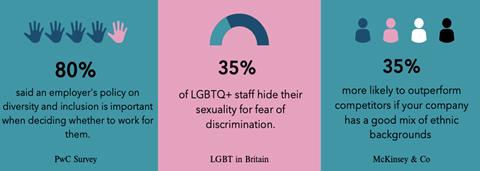Gazette Jobs Recruiter Services are here to help you attract, engage and retain the best talent for your firm
How to champion inclusive recruitment
Employers aiming to be more inclusive need to reflect EDI (Equality, Diversity, and Inclusion) in their recruitment process. The purpose of recruitment is to hire the most suitable candidate. However, if the talent pool is lacking diversity and inclusion, the search for such a candidate is hindered. For example, a practical toolkit for women in law (2019) found the following barriers: unconscious bias, gender pay gap, lack of senior role models, lack of support following maternity leave or other career breaks. It reported that the lack of truly flexible working opportunities make the profession difficult for those with caring responsibilities, disabilities and mental or long term health conditions.

To champion inclusive hiring, recruitment processes should be redesigned to reduce the influence of unconscious bias and discrimination.
Recruitment can inherently be a subjective process, making it particularly susceptible to unconscious biases. This is supported by the extensive evidence that marginalised groups face discrimination in hiring settings – including marginalisation by individuals, structures, and society in general.
While the evidence of discrimination is shocking and disheartening, increasing the awareness around recruitment biases and, more importantly, enacting change to confront the injustices is crucial. The intention is to enforce a more transparent and fair process to support more equal outcomes and improve candidates’ experiences.
Here is a guide to help employers ensure fair processes are set up to attract a more diverse talent pool.
Demonstrate your organisation’s values
An employer who values staff and embraces them is what will attract candidates and retain talent. Demonstrate your organisations’ commitment to diversity and inclusion by celebrating differences and individuality.
For example, the Law Society’s Employee Resource Groups (ERGs) work to represent various groups, offer support, raise awareness and build communities. This includes, our REACH (Race, Ethnicity, And Cultural Heritage), OutLaws (for members of the LGBTQ+ community and allies), Open Minds (mental health), and WAVE (Women’s Action and Voices for Equality) ERGs.
Redesign your job advert
Your job description should be clear, concise, and behaviour based. Rather than listing requirements for the role in terms of character traits, express them through behaviours that can be supported with evidence. Marginalised individuals are more likely to apply for roles that are behaviour-based or skill-based than character-based.
Remove biased language from your job advert, and reduce the number of stereotypically gender- coded words. Similarly, try to appeal to a wider demographic by avoiding age-coded language that could potentially dissuade older or younger candidates from applying.
Terminology around ‘person-organisation fit’ increase bias in hiring decisions. It often serves as a predictor of performance and could therefore undermine diversity – particularly when ‘fit’ is typically based on those already working at an organisation. Recruiting on this basis can worsen an employer’s inclusivity as it replicates the existing workforce.

Attracting diverse candidates
Try placing job adverts where they are more likely to be seen by marginalised applicants. For example, when targeting mothers returning to work after a career break, advertise with websites that cater to that audience.
Encourage members of staff to share vacancies with underrepresented groups in their personal networks. Hiring through employee referrals opens an additional avenue to reaching marginalised groups.
Enact outreach efforts by contacting schools and universities. Offer work-experience programmes or internship opportunities, alongside general career support.
Consider a wide range of sourcing methods, from posting job ads via social media to using professional networks and job boards. Work collaboratively and partner with charities that work with marginalised groups, such as disability organisations or racial and ethnic minority groups.
Inclusivity in the recruitment process
Keep job candidates informed about the key recruitment stages. This will support candidates with extenuating circumstances, like caring responsibilities or those who work inconsistent hours.
Take initiative and ask applicants if they require any adjustments during the application process, rather than waiting for them to submit a request. Offering reasonable adjustments and promoting inclusivity during the recruitment stage will encourage a more diverse selection of candidates to apply.
Examples of reasonable adjustments include but are not limited to: additional application/ assessment time, assistance, captions, hybrid interview options, accessible parking, Sign Language interpreter, and the option to specify something else not previously mentioned.
As a recruiter, you should ensure that you ask the exact same questions of all candidates during the interview stage. You should be basing your onboarding decisions on an applicant’s qualifications and skills rather than background.
Anonymise applications
“Blind recruitment” is the process of removing identifying information from application forms (including CVs and personal statements). By asking applicants to complete an anonymised form – omitting details such as names, contact details, attended schools/universities, etc. – rather than uploading their CV, you enhance the chances of avoiding bias. The hiring team are encouraged to evaluate candidates based on their skills and experiences instead of factors that may lead to biased decisions.
While it is undetermined whether anonymisation increases the number of marginalised candidates selected for interviews, the incognito nature the form affords suggests this method is ideal in obstructing bias.
Hybrid working
Flexible working arrangements provides a more inclusive environment for employees with caring responsibilities, accessibility requirements, and those returning from work after an illness. According to research from McKinsey (2021) employees with disabilities were 11% more likely to prefer a hybrid work model than employees without disabilities. Offering hybrid working will increase the likelihood of attracting a diverse selection of candidates and will provide your current employees with a better work-life balance.
Hybrid and flexible working have the potential to support inclusion and fairness through opening of the labour market to employees who cannot work in a traditional office-based role. It can give you a wider and more diverse pool of talent and open-up your job search. This in turn leads to a more positive company culture, however if poorly managed it could worsen existing inequalities and create new ‘in and out’ groups.
In a hybrid environment, organisations must ensure ongoing access to development and career conversations for all employees and make sure there is a fair allocation of work, opportunities, and voice.
A PwC survey reported that 80% said an employer’s diversity and inclusion policy is important when deciding where to work. Adopting an inclusive recruitment approach will not only widen up your candidate search but lead to a better and happier workplace.
Need help with your recruitment search? The Gazette Jobs Recruiter Services site is filled with helpful insights and guidance to help you through your recruitment journey. Stay up to date with all the latest market news through our Recruiter newsletter or book a call with our dedicated account managers to discuss your recruitment needs.
Find out more at recruiters.jobs.lawgazette.co.uk/

Stephen Pamnani
Recruitment Account Manager
sales@lawsociety.org.uk
0208 049 3834






























No comments yet